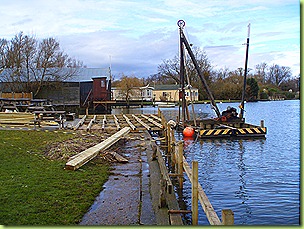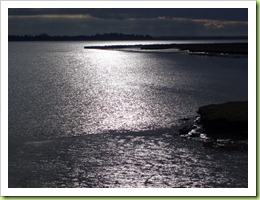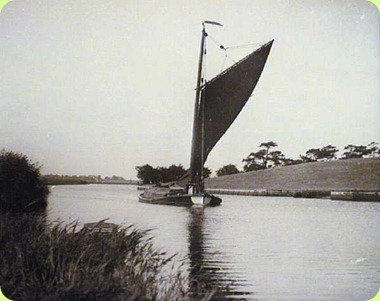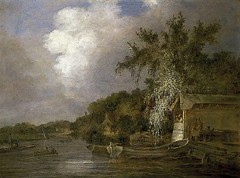
Saturday 27 February 2010
Back to business for Coldham Hall
Friday 26 February 2010
What next for the Loddon Swan?
“THERE’S A rule about the Premiership,” wrote one clever sports reporter a few weeks ago, “that as far as the media is concerned, one football club should always be in crisis.” I feel much the same about Wherryman’s Way pubs. Last year we feared for Coldham Hall after the bailiffs moved in. (It should re-open within weeks. See previous posts.) Then the Woods End at Bramerton was put up for sale – again more here. Now the future of The Swan at Loddon is in doubt after management company GRS Inns went into administration. Amazingly The Swan is one of four pubs which survive in Loddon/Chedgrave – but for how much longer? The White Horse does the restaurant/upmarket thing; the King’s Head looks after the footie lads, while The Angel does a good line in cosy chintz. And The Swan? Goodness knows I wouldn’t have the bottle or the business nous to run a boozer in these troubled economic times, but I can’t see who this pub is aiming at. Which is of course a crying shame. It started life as the grand coaching inn - some of the stable buildings still survive to the rear. And in the days when each town had its own court, the local magistrates met there too. But that’s all ancient history. These days it doesn’t feel so grand ..and this latest news means it doesn’t feel very well-loved either.
Saturday 20 February 2010
Breydon’s two King Arthurs
BREYDON Water provides a suitably epic conclusion to the Wherryman’s Way. Somehow it manages to be simultaneously very close to and very remote from neighbouring Great Yarmouth. This vast tidal estuary is home to many thousands of wading birds who find their food beneath the inter-tidal mudflats. If you’ve walked all the way from Norwich this part of your journey will feel wilder, colder and longer than every other stretch. It’s also the latest location to get the Literary Norfolk treatment. Click here for a comprehensive guide to Breydon’s two King Arthurs – naturalist turned writer Arthur Patterson and journalist turned children’s novelist Arthur Ransome.
Friday 19 February 2010
That book at last – we’re nearly there
THEY’RE cracking on with designing the Wherryman’s Way book down at Halsgrove in Somerset. Five years after I first put finger to keyboard I’m now seeing the results for the first time, complete with headlines and photos. This is one of my favourite pictures – an October dawn on the Chet with the white cap of Norton Marsh Mill just visible in the background. Over the last few years I’ve learnt to never travel anywhere without camera in pocket. All in all as we get ready for a May launch, this 43-year-old (ridiculously) does feel a little bit like a kid on Christmas Eve. For more details on the book from Halsgrove click here and wait for the (fairly hefty) Adobe document to load.
Thursday 18 February 2010
In celebration of Albion
THE TIGHT-KNIT world of wherrydom will be celebrating tomorrow as an epic restoration project finally comes to an end. Albion – one of only two surviving trading wherries - has had £200,000 spent on her over the last ten years. But now at last the job is done. “She's in the finest shape that she has ever been in since she was first built,” skipper Paul Henry Gowman told the EDP. "Albion will be back on the water this spring, as spruce and as beautiful as ever.” The tale of how she was rescued and restored is told in the classic Broads book Black-Sailed Traders. Sadly it’s out of print,but here’s a flavour as author Roy Clark and wherryman Jack Cates return to Albion at Buckenham on the Yare:
Jack cocked an eye at the banks of cloud galloping away to the south-west. “Be some shovin’ to do if it don’t back a bit,” he murmured. As he spoke I caught a glimpse of red bunting through the bare branches of the alders and poplars. It was the Albion’s weather vane whipping and straining in the stiff breeze. And from its direction it certainly looked as if we were in for “some shovin’”, a delightful understatement for the back-aching grind of quanting when the wind comes foul.
We clambered up onto the stretch of rough planking which served as a landing-place and where the Albion was secured. In the cold, grey morning light the gleaming vermillion, white, blue and yellow of her deck works would have cheered the dullest heart….
We were surprised to find the village constable leaning on his bicycle looking at her. “Morning,” said Jack “’bout early aren’t you?”
“Always on the job that’s us you know,” answered the constable with a broad grin…”Came along to get a few eggs from the farm yonder and thought I’d have a decko at the old girl we all read so much about in the papers. Gets photographed like a film-star doesn’t she?”
We had to agree. Ever since she had been converted back into a trading wherry under canvas, the Albion had received her full share of publicity. Now wherever she went, people stopped and looked at her, because she was the last of her kind, rigged out and painted as a wherry should be, and doing the work such craft have done on the rivers of Norfolk and Suffolk for centuries past.”
This was written circa 1950. The years when we might have lost her forever. But thanks to people like Cates and Clark and hundreds of others who have followed in their wake, she’s as good as new in 2010 …and still being photographed like a filmstar.
* Thanks to Mike Sparkes for the period photo. For more on the restoration see earlier post.
Wednesday 17 February 2010
King Street – the motion picture(s)
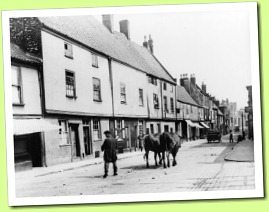 WE’RE ABOUT to learn a lot more about the history of King Street in Norwich thanks to a lottery fund grant for Dragon Hall. For those who don’t know Dragon Hall is the jewel in King Street’s crown, a magnificent medieval merchant’s hall dating back almost 600 years. The project is called King Street Community Voices and the idea is to “collect a digital archive of stories and memories about the area” over the next two years. It’s not just King Street, they’ll go as far as Bracondale in one direction and the cathedral in the other. And Wherryman’s Way fans will be delighted to know that the Wensum is the other boundary which should provide plenty of opportunities for tales from the riverbank. They’re going to kick off with a two-week show at Fusion in Norwich’s The Forum between March 15th and 26th including some rare footage shot inside The Old Barge Inn which used to be on one side of Dragon Hall. Oh and the picture shows a man driving cattle past an unrecognisable Dragon Hall in the late 1930s or early 1940s. Amazingly an Ipswich resident called Norman Bacon has already identified the man as Ted Carpenter. Mr Bacon was a 12-year old Butchers Boy on King Street at the time. They’ve obviously made a good start…
WE’RE ABOUT to learn a lot more about the history of King Street in Norwich thanks to a lottery fund grant for Dragon Hall. For those who don’t know Dragon Hall is the jewel in King Street’s crown, a magnificent medieval merchant’s hall dating back almost 600 years. The project is called King Street Community Voices and the idea is to “collect a digital archive of stories and memories about the area” over the next two years. It’s not just King Street, they’ll go as far as Bracondale in one direction and the cathedral in the other. And Wherryman’s Way fans will be delighted to know that the Wensum is the other boundary which should provide plenty of opportunities for tales from the riverbank. They’re going to kick off with a two-week show at Fusion in Norwich’s The Forum between March 15th and 26th including some rare footage shot inside The Old Barge Inn which used to be on one side of Dragon Hall. Oh and the picture shows a man driving cattle past an unrecognisable Dragon Hall in the late 1930s or early 1940s. Amazingly an Ipswich resident called Norman Bacon has already identified the man as Ted Carpenter. Mr Bacon was a 12-year old Butchers Boy on King Street at the time. They’ve obviously made a good start…
Sunday 14 February 2010
John Clare and the right to roam
 IF you ever find yourself with an hour to spare near Peterborough you could do an awful lot worse than visit the new John Clare museum in the nearby village of Helpston. Clare was a poet – they call him the peasant poet – in the early nineteenth century. His deep love of the land, has made him increasingly popular in these environmentally sensitive times. He was one of the few who railed against the injustices of the enclosure system which spread rapidly across the country throughout his lifetime. As a boy he had wandered freely across field and fen; as an adult he found himself on the wrong side of the new fences and hedges. This, he felt, was an outrage. So far so nineteenth century. But the audio tour around his beautifully restored cottage made me realise that the process goes on. One of the many pleasures of writing my book has been chatting to the older generation about how things used to be. If there was a common theme, it was a regret over the ever-weakening right to roam. Octagenarian Cecil Nicholls of Loddon for example remembers taking the ferry from Langley to Cantley via a public footpath called Loades Carnser. Today the ferry is long-gone and the “Private” signs could not be larger. In fact methinks they protest too much. Sixty-something Phil Reeves from Surlingham swears there was a direct footpath to Surlingham Broad from a surviving path near Coldham Hall. There’s no sign of it now. More generally on the Wherryman’s Way we are pulled away from the river by one big house with stubbornly big grounds. But things are stirring. The government is already talking about giving us a right to walk freely along the entire British coastline. Griff Rhys Jones among others is campaigning for the right to canoe along all of our rivers. Maybe we’re starting to listen to John Clare at last.
IF you ever find yourself with an hour to spare near Peterborough you could do an awful lot worse than visit the new John Clare museum in the nearby village of Helpston. Clare was a poet – they call him the peasant poet – in the early nineteenth century. His deep love of the land, has made him increasingly popular in these environmentally sensitive times. He was one of the few who railed against the injustices of the enclosure system which spread rapidly across the country throughout his lifetime. As a boy he had wandered freely across field and fen; as an adult he found himself on the wrong side of the new fences and hedges. This, he felt, was an outrage. So far so nineteenth century. But the audio tour around his beautifully restored cottage made me realise that the process goes on. One of the many pleasures of writing my book has been chatting to the older generation about how things used to be. If there was a common theme, it was a regret over the ever-weakening right to roam. Octagenarian Cecil Nicholls of Loddon for example remembers taking the ferry from Langley to Cantley via a public footpath called Loades Carnser. Today the ferry is long-gone and the “Private” signs could not be larger. In fact methinks they protest too much. Sixty-something Phil Reeves from Surlingham swears there was a direct footpath to Surlingham Broad from a surviving path near Coldham Hall. There’s no sign of it now. More generally on the Wherryman’s Way we are pulled away from the river by one big house with stubbornly big grounds. But things are stirring. The government is already talking about giving us a right to walk freely along the entire British coastline. Griff Rhys Jones among others is campaigning for the right to canoe along all of our rivers. Maybe we’re starting to listen to John Clare at last.
Friday 12 February 2010
A new chapter for the Ferry Boat - at last
 SO the old Ferry Boat in Norwich is going to become a backpackers' hostel. Does that deserve two cheers or three? If you've read previous posts, you'll know the score by now. King Street is arguably Norwich's first street and it used to be chock-a-block full of businesses, ferries and pubs. Therefore - because all the other pubs have disappeared - this riverside building is quite important to the city's history. And yet if it's not going to survive as a pub, we could do a lot worse than a hostel. According to the BBC news website the Ferry Boat has been bought by the family which runs the Deepdale Farm hostel on the north Norfolk coast. Down here they plan canoeing, cycling and a cafe as well as accommodation. Could it become the unofficial start of the Wherryman's Way in the future?
SO the old Ferry Boat in Norwich is going to become a backpackers' hostel. Does that deserve two cheers or three? If you've read previous posts, you'll know the score by now. King Street is arguably Norwich's first street and it used to be chock-a-block full of businesses, ferries and pubs. Therefore - because all the other pubs have disappeared - this riverside building is quite important to the city's history. And yet if it's not going to survive as a pub, we could do a lot worse than a hostel. According to the BBC news website the Ferry Boat has been bought by the family which runs the Deepdale Farm hostel on the north Norfolk coast. Down here they plan canoeing, cycling and a cafe as well as accommodation. Could it become the unofficial start of the Wherryman's Way in the future?
Sunday 7 February 2010
Why John Crome was a Wherryman's Way fan
Its two leading lights were John Sell Cotman and John Crome. Together, at the beginning of the 19th century, they helped form a school which would last three generations. Its significance, says the Norwich Museum blurb, lies in "a realism based on direct observation".
Yes, yes, but what's this got to do with the Wherryman's Way? Well the extraordinary thing is that people like Cotman and Crome - together with others like Joseph Stannard and George Vincent - delighted in painting WW scenes. They painted the Wensum, they loved Trowse Meadows. Postwick, Whitlingham, Thorpe, Brundall and Great Yarmouth are all beautifully captured. Stepping into these galleries is to see some of the greatest painters of their day immortalising scenes that are still partially recognisable to us today.
* For more on the Norwich School of Artists see the Literary Norfolk website. This picture shows The Yare at Thorpe by John Crome.
* The Watercolour exhibition at the Castle Museum runs until April 18th, 2010
